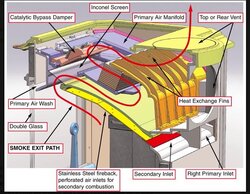rideau
Minister of Fire
Tony, I keep my stovetop thermometer on the cast iron deck behind the soapstone, just before the flue collar area. I believe a lot of owners do. It gives a better. quicker read for engaging the cat. I leave the thermometer there. On a hot fire it goes up to 525 or so. I usually run the stove at 425 or 450, temp read there. I believe it gives an accurate understanding of the firebox temp...about twice that on the thermometer. just gets there faster than on the soapstone. I also believe that is where Wolf has he thermometer when he is reading the stated temperature. It's not the exit temp to the flue that he is reading.
Hope Wolf lets us know how he is doing with the stove...
Hope Wolf lets us know how he is doing with the stove...



 I actually have to close my door and turn on my room-to-room transfer fan and it just maintains the temperature so I don't roast while I sleep. The coldest part of the house is the family room, which is on the same level as the stove, without a fan moving the air into it, can stay around 66-69 degrees once everything is up to temp and cruising for a while.
I actually have to close my door and turn on my room-to-room transfer fan and it just maintains the temperature so I don't roast while I sleep. The coldest part of the house is the family room, which is on the same level as the stove, without a fan moving the air into it, can stay around 66-69 degrees once everything is up to temp and cruising for a while.